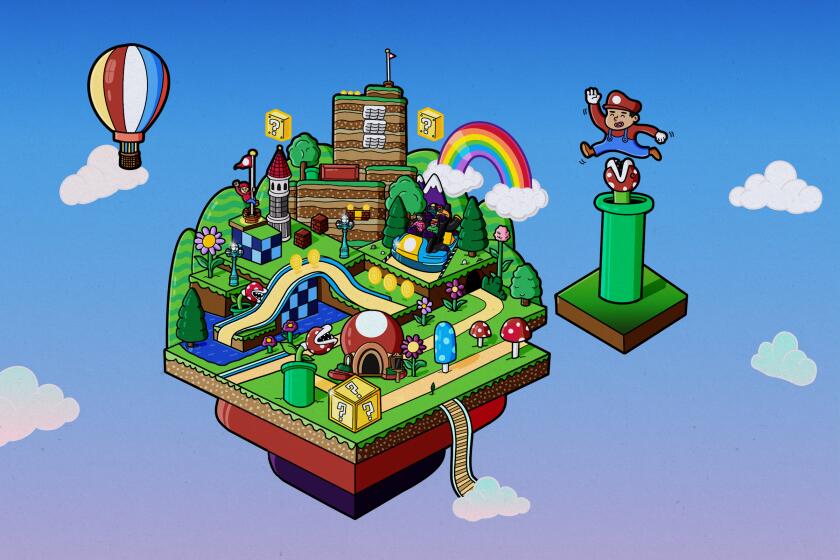It’s No Mirage
A cluster of New York’s great iconic monuments plunges upward into a Nevada sky. Oddly out of proportion, soaring Art Deco towers and Modernist skyscrapers loom over Ellis Island and the Brooklyn Bridge, all huddled together in the vast nothingness of the desert. It is a freakish apparition.
When New York-New York opens Jan. 3, Las Vegas’ newest hotel-casino complex will be a titillating fusion of fantasy and reality. At a cost of $460 million--nearly six times the amount of Manhattan’s annual expense budget for cultural affairs--the massive structure is an eerie reproduction of the real city at one-third scale. But these gleaming skyscrapers will house 2,035 hotel rooms, and the dense casino below will compress the chaos of Times Square, Little Italy and Wall Street around the ubiquitous slot machines and gaming tables.
Ominously, the fate of both New Yorks--the real and the artificial--also mirror each other.
While Las Vegas is creating an uncanny imitation of a real city, Manhattan today is increasingly becoming a playground for wide-eyed tourists: Disney has already begun to transform New York’s once-seedy 42nd Street into a sanitized corporate dream. Both cities now compete for the same tourist dollars. Vegas’ New York-New York is a lens into the city of tomorrow. Who is to say which will be the more real?
Founded on the desire to escape the binding conventions of daily life, Las Vegas is a city where barriers between good and evil, authentic and fake, good taste and bad have no meaning. Mock Egyptian tombs are laid out near tropical rain forests. An ornately painted piano from Versailles stands next to a rhinestone-embedded baby grand. Queen Elizabeth’s gold-rimmed crystal goblets are reproduced and engraved with Liberace’s initials. Value judgments seem beside the point.
*
New York-New York is the first casino to attempt to re-create a contemporary city. Veiled in secrecy until it opens, its interior is still off-limits to journalists and critics. But wandering around the exterior is like driving up over the Triborough Bridge into Manhattan--you are confronted with a world of seductive secrets and broken dreams. It is clearly a fake, but who cares? That is its allure; this dream, full of saccharine nostalgia, seems deceptively safe and cheerful. There is no suffering here; if you run out of money you discreetly disappear.
To the hotel’s designers, Neal Gaskin and Ilia Bezansky, the real city was irrelevant. Rather than visit New York, they scrupulously inspected images from travel books and studied architectural drawings. Nevertheless, their intent was to create an “authentic” city. New York-New York is not a cartoon but the world’s largest piece of Pop art, Gaskin says. Either way, it is something new for Vegas--its object is not only to imitate a city but to usurp it.
New York-New York completes a quartet of casinos at the intersection of Tropicana Avenue and Las Vegas Boulevard. Across the street, the gigantic MGM-Grand masks its casino and Disney-like theme park behind a cool corporate facade and a giant, glowing lion’s head. Nearby, the Excalibur rises like a splashy cartoon of a medieval castle across from the Tropicana’s leafy paradise. Each has a bluntly cheerful theme set in the gloom of the desert strip.
From the exterior, the new complex is a carefully proportioned, three-dimensional construction. The 12 hotel towers are set back and staggered to give the illusion of free-standing buildings. Below, a seemingly random clutter of monuments--Ellis Island next to Grand Central Terminal--evokes a hazy sense of reality. The result is neither convincingly real nor completely fake. The illusion holds.
History and time are suspended, as if the city were dipped in formaldehyde. The Art Deco Empire State and Chrysler buildings are flanked by icons of corporate Modernism from the 1950s, including Park Avenue’s glistening stainless-steel Lever House and Mies van der Rohe’s more austere Seagram Building. With facades constructed of hard fiberglass, each monument is preserved forever in a perfect state of agedness--neither too fresh nor too worn.
Inside the ground-floor casino and restaurant areas, designed by Yates-Silverman Inc., that mock grittiness will be carefully fine-tuned; steam will rise from steel manhole covers in the casino and faded curtains will hang in false windows. Central Park’s tranquil ponds and bum-proof benches will be shaded under 50 artificial trees, while Little Italy, which struggles to survive in the real Manhattan, will be securely frozen in time, its back alleyways crowded with graffitied stoops and wrought-iron fire escapes.
Even the congestion that spawned Manhattan’s frenzied drive skyward is strangely simulated here. Twelve skyscrapers and 383,000 square feet of casino and public spaces are compressed into a tight 20-acre site. With no outer boroughs to relieve the tension, the Vegas version of Coney Island’s roller coaster is wrapped right into the city, crashing in and out of the towers themselves. Chaos and congestion here will feel as real as in the real thing.
That chaos will only reinforce the harder reality of Vegas, which will seep into all corners of the casino. The replicas of the green iron-and-glass subway entrance at New York’s Astor Place that will enclose the gaming tables will also support surveillance cameras. And since money, of course, is still the raison d’e^tre here, change cups will rattle as loudly as ever with falling quarters, drawing gamblers to the machines. That only confirms the adult lure.
*
But New York-New York’s believability is possible only because of the growing artificiality of the real one. Las Vegas’ Grand Central may be an empty facade, but the real version is being cleverly recast as a mini-mall, its cavernous public spaces stuffed with restaurants. Times Square is in the process of becoming a Disney-fied play land--safe from sin but greed-driven nonetheless. Meanwhile, 57th Street is already a mundane strip of the same indistinguishable theme restaurants that can be found from Sydney to Los Angeles.
There is an element of genuine restoration to many of these efforts. But the developers’ aim is to repress the reality of life in the city behind a pleasant false facade.
Meanwhile, the delicious sin that was once associated with Vegas is now more discreet--hidden from the eyes of the children who now walk the streets with their parents, mouths gaping. Along the Strip, middle-aged couples strolling from one shop-laden theme park to another have replaced hustlers and hookers.
Yet that too is a masquerade: Vegas, the fastest-growing city in the United States, has an urban underbelly like that of any other major city. The number of homicides in central Vegas is approaching 150 this year alone. If the city of New York is pushing peep shows off 42nd Street and into the outer boroughs, Vegas has also pushed much of its prostitution to bordering towns where it is less visible--but easy to reach.
But Vegas remains essentially an oasis of escapism. And that was always the point: to provide an alluring, temporary opiate. The real fear is that we are no longer able to distinguish between the false New York and the real one. In a living city, the desire to hide the truth about the urban environment--the neglected that are tucked away in its corners, the social conflicts--has a more sinister bent. In that sense, the false New York is a more honest world.
Sign up for The Wild
We’ll help you find the best places to hike, bike and run, as well as the perfect silent spots for meditation and yoga.
You may occasionally receive promotional content from the Los Angeles Times.



